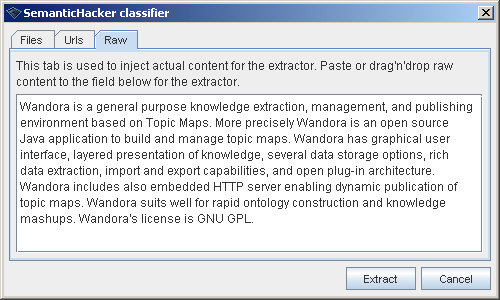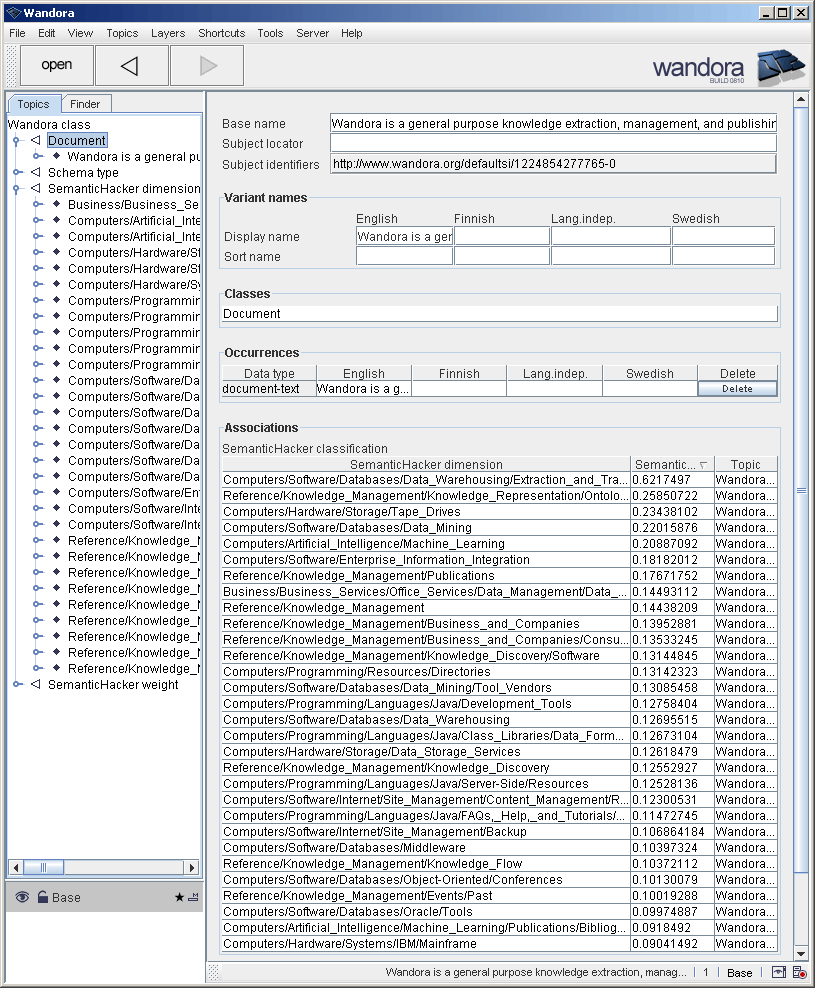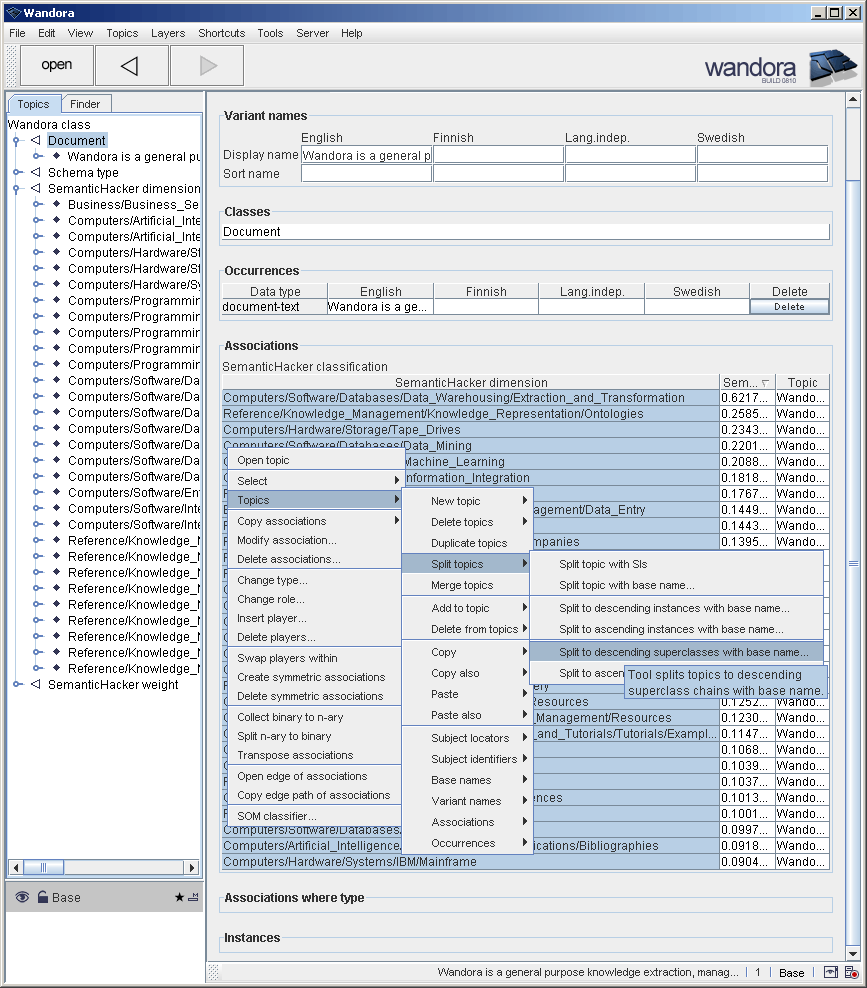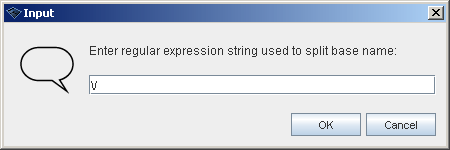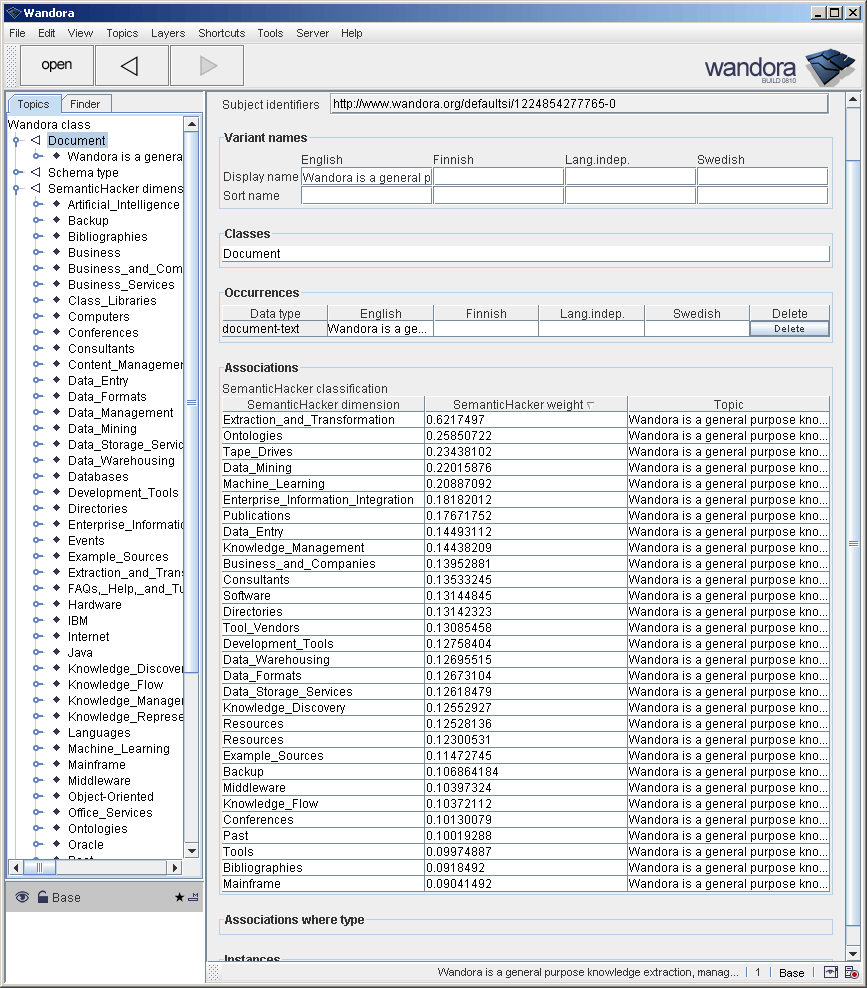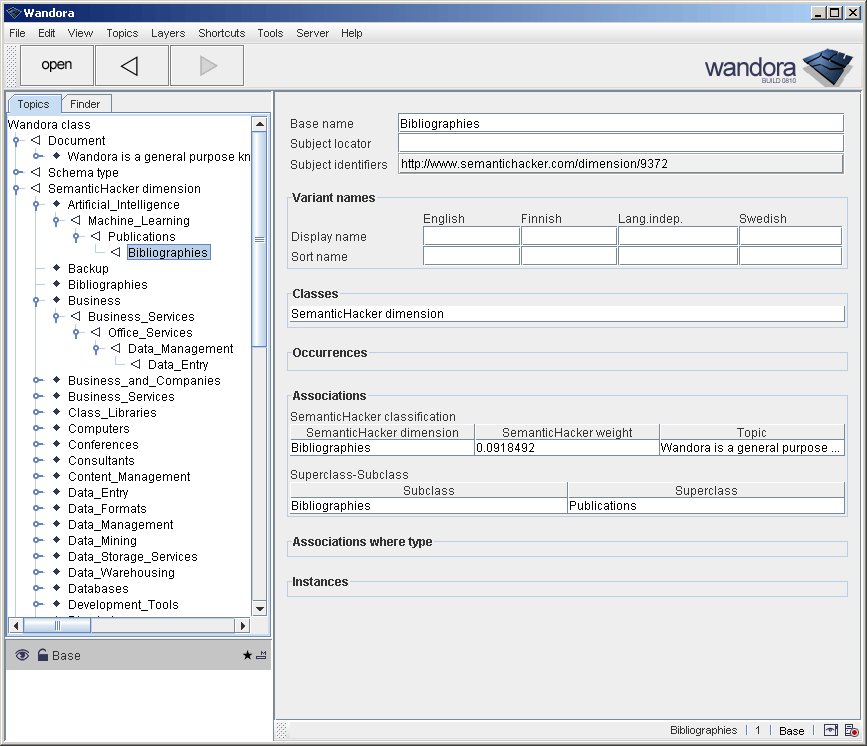SemanticHacker classifier
(→SemanticHacker classification example continued) |
|||
| (20 intermediate revisions by one user not shown) | |||
| Line 1: | Line 1: | ||
| − | + | '''SemanticHacker classifier was one of the first classifiers in Wandora. Although the original SemanticHacker API still is available, developers can not acquire API keys for the original SemanticHacker API any more. TextWise, the company providing SemanticHacker API has also a similar API and we have changed the SemanticHacker classifier to the TextWise classifier.''' | |
| − | SemanticHacker classifier requires valid api token from SemanticHacker. You can apply your token [http://www.semantichacker.com/ | + | Wandora's SemanticHacker classifier requests a text document and classifies it using [http://www.semantichacker.com SemanticHacker's] Simplified Semantic Signature. The effect is that given text document or fragment is tagged with several tags possibly reflecting the content of the text. However, tags and tag weights provided by the SemanticHacker should be considered as an entity signature of the text. This is little different perspective compared to [[OpenCalais classifier]] for example. |
| + | |||
| + | SemanticHacker classifier requires valid api token from SemanticHacker. You can apply your token [http://www.semantichacker.com/ here]. | ||
== SemanticHacker classification example == | == SemanticHacker classification example == | ||
| − | SemanticHacker classifier starts with menu option '''File > Extract > SemanticHacker classifier...'''. Let's try to classify WandoraWiki's first text chapter. | + | SemanticHacker classifier starts with menu option '''File > Extract > Classification > SemanticHacker classifier...'''. Let's try to classify WandoraWiki's first text chapter. |
| Line 11: | Line 13: | ||
| − | Before classification Wandora requests SemanticHacker api key used to access the web api. Wandora does not store the key between use sessions. | + | Before classification Wandora requests SemanticHacker api key used to access the web api. Wandora does not store the key between use sessions. If api key is valid and classification was successful, Wandora creates a topic for the text document and all SemanticHacker provided semantic dimensions and weights. Below is a screenshot of Wandora with a SemanticHacker tagged text document topic open. |
[[Image:semantichacker_example.gif|center]] | [[Image:semantichacker_example.gif|center]] | ||
| − | |||
== SemanticHacker classification example continued == | == SemanticHacker classification example continued == | ||
| − | Although it was expressed above that SemanticHacker classification should be considered as a single signature entity, you might find it useful to chop down SemanticHacker dimensions. By default SemanticHacker dimension is a slash separated keyword list and one could assume keyword chain respects superclass-subclass relation i.e. left side keyword can be seen as a superclass of right side keyword. Next screenshots demonstrate how you can postprocess dimension keywords provided by the SemanticHacker. | + | Although it was expressed above that SemanticHacker classification should be considered as a single signature entity, you might find it useful to chop down SemanticHacker dimensions. By default SemanticHacker dimension is a slash separated keyword list and one could assume keyword chain respects superclass-subclass relation i.e. left side keyword can be seen as a superclass of right side keyword. Next screenshots demonstrate how you can postprocess dimension keywords provided by the SemanticHacker. Split operation is not SemanticHacker specific but can be used in any context where you need to split down topics to a chain of superclass-subclass topics. |
| Line 26: | Line 27: | ||
[[Image:semantichacker_post2.gif|center]] | [[Image:semantichacker_post2.gif|center]] | ||
| + | |||
| + | Note: Regular expression used to split base names is a combination of back slash and slash character. Yes, it looks like V but isn't! | ||
| Line 31: | Line 34: | ||
| − | [[Image: | + | [[Image:semantichacker_post4.gif|center]] |
| + | |||
| + | == Additional notes == | ||
| + | |||
| + | * SemanticHacker classifier accepts only texts with less than 1000 characters. | ||
| + | |||
| + | == See also == | ||
| + | |||
| + | * [[OpenCalais classifier]] | ||
| + | * [[Tagthe extractor]] | ||
| + | * [[Yahoo! YQL term extractor]] | ||
| + | * [[AlchemyAPI extractors]] | ||
| + | * [[Zemanta extractor]] | ||
| + | * [[GATE/ANNIE integration|GATE/ANNIE]] | ||
| + | * [[Stanford Named Entity Recognizer integration|Stanford Named Entity Recognizer (NER)]] | ||
| + | * [[UClassify integration]] | ||
Latest revision as of 18:54, 5 October 2013
SemanticHacker classifier was one of the first classifiers in Wandora. Although the original SemanticHacker API still is available, developers can not acquire API keys for the original SemanticHacker API any more. TextWise, the company providing SemanticHacker API has also a similar API and we have changed the SemanticHacker classifier to the TextWise classifier.
Wandora's SemanticHacker classifier requests a text document and classifies it using SemanticHacker's Simplified Semantic Signature. The effect is that given text document or fragment is tagged with several tags possibly reflecting the content of the text. However, tags and tag weights provided by the SemanticHacker should be considered as an entity signature of the text. This is little different perspective compared to OpenCalais classifier for example.
SemanticHacker classifier requires valid api token from SemanticHacker. You can apply your token here.
Contents |
[edit] SemanticHacker classification example
SemanticHacker classifier starts with menu option File > Extract > Classification > SemanticHacker classifier.... Let's try to classify WandoraWiki's first text chapter.
Before classification Wandora requests SemanticHacker api key used to access the web api. Wandora does not store the key between use sessions. If api key is valid and classification was successful, Wandora creates a topic for the text document and all SemanticHacker provided semantic dimensions and weights. Below is a screenshot of Wandora with a SemanticHacker tagged text document topic open.
[edit] SemanticHacker classification example continued
Although it was expressed above that SemanticHacker classification should be considered as a single signature entity, you might find it useful to chop down SemanticHacker dimensions. By default SemanticHacker dimension is a slash separated keyword list and one could assume keyword chain respects superclass-subclass relation i.e. left side keyword can be seen as a superclass of right side keyword. Next screenshots demonstrate how you can postprocess dimension keywords provided by the SemanticHacker. Split operation is not SemanticHacker specific but can be used in any context where you need to split down topics to a chain of superclass-subclass topics.
Note: Regular expression used to split base names is a combination of back slash and slash character. Yes, it looks like V but isn't!
[edit] Additional notes
- SemanticHacker classifier accepts only texts with less than 1000 characters.
